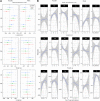Prenatal exposure to metal mixture and sex-specific birth outcomes in the New Hampshire Birth Cohort Study
- PMID: 31844832
- PMCID: PMC6914313
- DOI: 10.1097/EE9.0000000000000068
Prenatal exposure to metal mixture and sex-specific birth outcomes in the New Hampshire Birth Cohort Study
Abstract
Background: In utero exposure to individual metals may impact fetal growth, though little is known about the effects of exposure to metal mixtures. Therefore, we investigated joint effects of in utero exposure to a mixture of As (arsenic), Mn (manganese), and Pb (lead) on newborn outcomes in a United States population.
Methods: Concentrations of As, Mn, and Pb were determined in maternal postpartum toenail samples, a biomarker of in utero exposure, from 989 maternal-infant pairs (492 females and 497 males). Newborns' anthropometric characteristics, including head circumference, length, and weight, were obtained from medical records. The joint effects of the three metals were modeled using Bayesian kernel machine regression and linear regression. Both sex-combined and sex-stratified statistical analyses were performed.
Results: We observed an inverted-U-shape association between maternal toenail Mn concentrations and newborn head circumference, particularly among female infants. Concentrations of Pb were related to reduced head circumference, weight, and length, especially among females at lower concentrations of the other metals. Overall, toenail As concentrations were related to reduced head circumference, especially among males, and an increase in birth length and weight among females. We found little evidence of As interactions with other metals within the mixture.
Conclusions: Our findings suggest that in utero metal mixture exposures may influence birth outcomes, and that such relations may differ by infant sex.
Keywords: arsenic; in utero exposure; lead; manganese; metal mixture; newborns’ size; sex.
Conflict of interest statement
The authors declare that they have no conflicts of interest with regard to the content of this report.
Figures

References
Grants and funding
LinkOut - more resources
Full Text Sources
Research Materials
